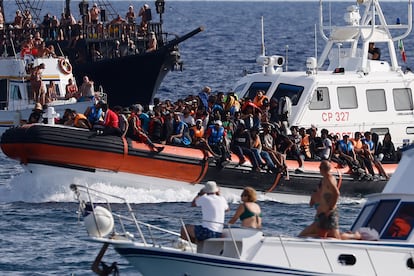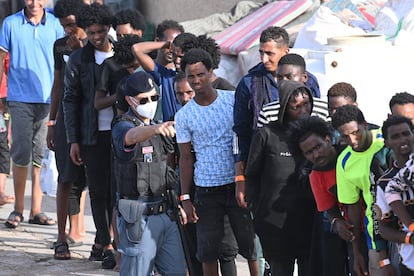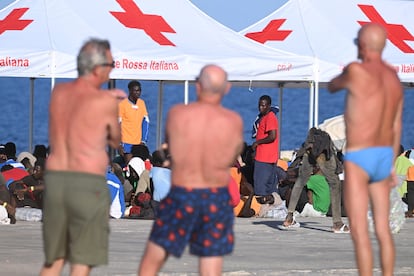A gateway to Europe for migrants and a paradise for tourists: The two Lampedusas that rarely intersect
The Italian island that has received 12,000 people in search of a new life this week is also home to a thriving leisure industry that welcomes 30,000 travelers every year

The Italian coast guard rescues, off the coast of Lampedusa, a drifting barge loaded with migrants trying to reach Europe through the Mediterranean. They are transferred to a military ship and taken to the port. At the dock, they will be identified and treated by doctors. Then they will go to the buses that will take them to the reception center, where they will stay for a few days until they leave the island on a boat heading to the reception centers in Sicily or the mainland. To the tourists who, a few feet from the landing area, mix with the locals in the urban center — full of bars with terraces and shops — after a day at the beach, in the bustle of a September Sunday afternoon (still high season in Lampedusa), they are barely ghosts.
The beaches, restaurants, and hotels are still full. In the most prosperous years, up to 30,000 tourists, mostly Italian, come to this island of about 6,000 residents. There is no data to suggest that immigration harms in any way the economic activity of Lampedusa.

On summer nights, the streets of the center of the island become an open-air party, with concerts that go on well into the early hours of the morning and souvenir shops still open after midnight. Not far from there, in the church square, long lines of migrants wait to receive a plate of hot food. Although this happens almost every day, they do not come across the tourists, who dine on the terraces of nearby restaurants.
This week has been unusual in every sense. Nearly 12,000 migrants arrived in Lampedusa in just a few days, and the exception that proves the rule occurred: a group of boys from the Gambia, Liberia, Ivory Coast and Nigeria who had just landed on the island danced with tourists and locals to the rhythm of Bob Marley’s reggae. This almost never happens. But most of the neighbors, who have gone out of their way to bring clothes, blankets, water and food, celebrate it as a sign of welcome and normality.
Two reception systems coexist in Lampedusa: one for tourists and one for migrants arriving through the Mediterranean. Some see the island as a holiday paradise. For others, who are fleeing hunger, natural disasters or war, it represents the gateway to Europe, the end of a dangerous sea voyage in which they risk their lives. To date, the International Organization for Migration (IOM) estimates that more than 2,000 people who left North Africa trying to reach Italy have died in the central Mediterranean.

Nevertheless, a tourist could spend weeks on the island without ever knowing what is taking place just a short distance away. Everything is organized so that the immigration issue does not interfere with local life. “There are two parallel channels that do not intersect. When everything is working normally, tourists don’t see migrants. These days of emergency there were migrants on the streets, asking peacefully for food, water. Some chose to offer them assistance, while others chose not to,” Giusi Nicolini, former mayor of Lampedusa, explains to EL PAÍS.
In general, many people who live or work in Lampedusa explain that there are very few points where the experiences of those who arrive by sea on an iron barge coincide with those of the rest of the people on the island.
The reception center is located approximately 1.5 miles from the port, nestled on a small hill, in an area with no hotels or vacation homes. Less than half a mile away, there is a landfill. Seeing the place from the central streets with the naked eye is impossible. In the urban area of Lampedusa, populated by a swarm of sun-drenched low houses, a mural depicts the drama that migrants go through when they take to the sea to reach Europe.
Filippo Mannino, the head of a right-wing coalition, has been the mayor of Lampedusa for a little over a year. Among other things, he has kept in force an ordinance that prohibits people housed in the reception center from leaving the premises. This rule was implemented in 2020 due to the pandemic, and, even though the health reasons no longer apply, the politician decided to maintain it. Currently, only those who have the strength to jump the fence and elude the army — which patrols the outside of the facility — can leave the reception center.
Protesting the government management
Recently, Mannino suggested, without evidence, that if the management of immigrants is too visible, it becomes detrimental to tourism. “The goal of the government and this administration must be to minimize the impact of the reception in this territory, because we actually live from tourism and we want to continue living from it,” he stated. The vice mayor, Attilo Lucia, has echoed this message and has encouraged the locals to protest against Rome’s migration management.
The former mayor, Giusi Nicolini (who a decade ago, in the midst of the refugee crisis, exported an exciting message of welcome that was replicated by many local governments of Europe) rejects that vision. “The presence of migrants is not a problem; if that was the case, this island would be at risk of depopulation. Instead, it is a place that is growing demographically and where profits from tourism are increasing more and more. In fact, it is a positive example that shows that coexistence is possible, and that welcoming people harms no one,” she says.
“We came to spend a few days relaxing at the sea. We met a group of boys asking for food and water. We gave it to them and chatted with them for a while. We learned their stories. It was going to be a normal vacation, and it became an enriching experience,” says Ilaria Benedetti, a Roman tourist who visited the island with her husband and two children.
Many local workers do not think that immigration will affect the island’s image. “We barely see the migrants, because they arrive in the boats, and they’re taken directly from the port to the reception center. Their arrival does not affect tourism in any way, why would it? Hotels and restaurants continue to hang signs announcing that they are full; that is the proof,” says Emanuele, a taxi driver. “Immigration and tourism are different things,” agrees Luciana, who works in a craft store.
One of the few places where tourists and migrants do meet is the island’s outpatient clinic, which is divided into three sections: one for the locals, the emergency section for tourists (active from mid-June to mid-September) and the unit that cares for migrants. The three sections are located in different parts of the outpatient clinic, but they share the same waiting room. Here, a tourist injured by a jellyfish on the beach and a woman arriving from Libya with signs of violence after months in immigration detention centers can find themselves sitting next to each other.
The island’s small cemetery is another space that everyone shares. There, the graves of the migrants who lost their lives in the water are not far from the rest. For years (until it ran out of space) some foreign victims of the sea were buried there in unmarked graves that read: “Here lies an unidentified immigrant.” Someone left flowers and a small wooden boat on them, and decorated them with drawings. The IOM estimates that, since 2014, approximately 17,000 people have disappeared in the waters of the Mediterranean while trying to reach Europe.
Sign up for our weekly newsletter to get more English-language news coverage from EL PAÍS USA Edition
Tu suscripción se está usando en otro dispositivo
¿Quieres añadir otro usuario a tu suscripción?
Si continúas leyendo en este dispositivo, no se podrá leer en el otro.
FlechaTu suscripción se está usando en otro dispositivo y solo puedes acceder a EL PAÍS desde un dispositivo a la vez.
Si quieres compartir tu cuenta, cambia tu suscripción a la modalidad Premium, así podrás añadir otro usuario. Cada uno accederá con su propia cuenta de email, lo que os permitirá personalizar vuestra experiencia en EL PAÍS.
¿Tienes una suscripción de empresa? Accede aquí para contratar más cuentas.
En el caso de no saber quién está usando tu cuenta, te recomendamos cambiar tu contraseña aquí.
Si decides continuar compartiendo tu cuenta, este mensaje se mostrará en tu dispositivo y en el de la otra persona que está usando tu cuenta de forma indefinida, afectando a tu experiencia de lectura. Puedes consultar aquí los términos y condiciones de la suscripción digital.
More information
Archived In
Últimas noticias
Welcome to the post-religion era: The idea of Christianity as the absolute truth has become obsolete
‘I thought you would like it’: The risky sexual practice popularized by TV shows and TikTok
The digitalization of tourism: ‘They promise experiences and gave us the worst possible one’
Mexican peso defies uncertainty with forecasts of a new period of stability in 2026
Most viewed
- Sinaloa Cartel war is taking its toll on Los Chapitos
- Reinhard Genzel, Nobel laureate in physics: ‘One-minute videos will never give you the truth’
- Oona Chaplin: ‘I told James Cameron that I was living in a treehouse and starting a permaculture project with a friend’
- Why the price of coffee has skyrocketed: from Brazilian plantations to specialty coffee houses
- Silver prices are going crazy: This is what’s fueling the rally











































